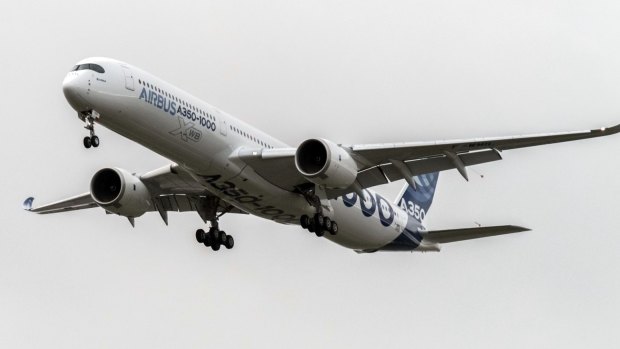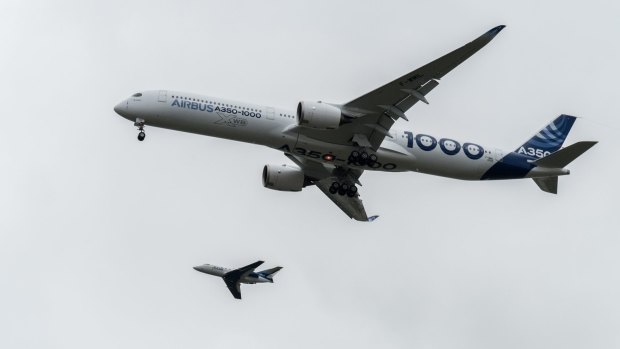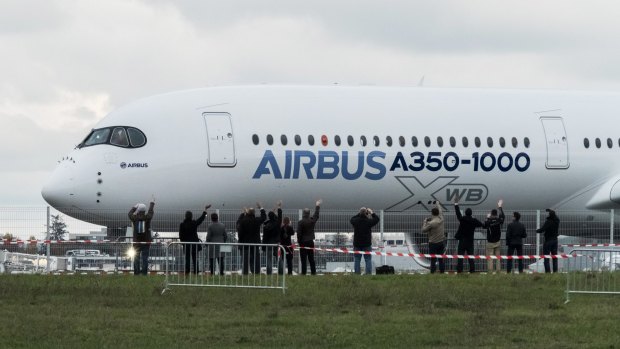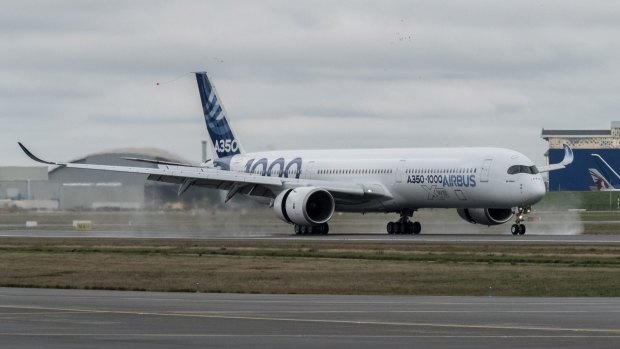This was published 7 years ago
Airbus A350-1000 plane makes first flight at event in Toulouse, while 'ghost plane' also rolls out
Europe's largest twin-engined passenger jet, the Airbus A350-1000, took to the skies for the first time on Thursday, seeking to grab the spotlight from Boeing's popular 777.
Though some attention was focused on the roll out of a "ghost plane" at the same time that made its debut with no livery - usually a taboo in the airline industry.
The lightweight carbon-fibre plane, 7 metres longer and able to carry 40 more people than A350s already in service, began a three-hour debut flight watched by some of the airline bosses who have invested in the $US356 million jet ($A480 million).

The Airbus A350-1000 comes into land following its first flight at the Airbus factory in Toulouse, France, on Thursday.Credit: Bloomberg
The 366-seat A350-1000 is designed to break Boeing's virtual monopoly in the lucrative "mini-jumbo" segment, typically involving large twin-engined jets carrying 350 people.
It is a larger cousin to the new-generation A350-900, which entered service last year. Both are built from similar advanced materials to Boeing's mid-sized 787 Dreamliner in a race between planemakers for fuel savings and better passenger comfort.
The aircraft involved in Thursday's Toulouse debut is one of three test planes facing 1600 hours of intensive flight testing before the A350-1000 enters service in the second half of 2017.

The Airbus A350-1000 makes its first flight.Credit: Bloomberg
Fabrice Bregier, chief executive of the planemaking division of Airbus Group, said he was confident the A350-1000 would be delivered on time to launch customer Qatar Airways.
"It makes me very happy and very proud. We are flying according to the timetable we had planned," he said moments after the jet, weighing 230 tonnes, took off under leaden skies to applause from factory workers.
While the first flight of its latest model took place on time, Airbus is grappling with delivery delays to the earlier A350-900, clusters of which remain dotted around the airport in Toulouse, France, due to shortages of cabin equipment.

The A350-1000 twinjet passenger plane stands on the tarmac following its first flight at the Airbus factory in Toulouse, France.Credit: Bloomberg
Smaller A320neo jets are also parked with missing engines, due to delays in supplies from Pratt & Whitney, highlighting the strain on the industry of adding new technology while securing record production targets.
Airbus programmes chief Didier Evrard said the planemaker continued to scrutinise its suppliers, notably France's Zodiac Aerospace, which said this week it was on a path to recovery following a production crisis at its factories.
Asked about the progress displayed by cabin and other suppliers for the A350 family, Evrard told Reuters: "It has improved, but it is not where it should be and we are watching them very carefully."

The Airbus A350-1000 lands following its first flight.Credit: Bloomberg
He said the planemaker was working hard to achieve a target of 50 A350-900 deliveries for this year, having reached 34 so far, with a further plane due to be delivered later on Thursday.
"I have already cancelled my holidays," he added.
Airbus says the A350-1000 will be 25 per cent cheaper to operate than the competing Boeing 777-300ER, an older aircraft which weighs more but which has more seats in some layouts.
Boeing has responded to the A350-1000 by developing an even larger version of 777 able to seat over 400 people, making it the largest twin-engined jet when it enters service in 2020.
Airbus is also considering whether to go up in size with a further stretch of the A350, but senior marketing vice president Francois Caudron said it did not currently deem this necessary.
Industry sources say Airbus is nonetheless offering the potential "A350-2000" to influential buyers including Singapore Airlines and British Airways.
Such a jet would need an enhancement of the Rolls-Royce Trent XWB engine that powers the A350-1000, already one of the industry's largest with a fan case large enough to swallow the fuselage of the now defunct Concorde.
Chris Young, programmes director at the embattled UK engine manufacturer, which is in the midst of restructuring, said it would always be ready if needed to upgrade its engines or add new ones according to the needs of airplane manufacturers.
Meanwhile, Airbus also presented dignitaries and media assembled for the debut of its latest model with an unexpected sight on Thursday: a white-painted $US300-million A350 jetliner being prepared for delivery without an airline livery, breaking an industry taboo.
So-called white-tails are considered an alarm signal in the aerospace industry because they usually signify that they have been built without an airline in place to operate them, though in rare cases buyers can decide to paint them elsewhere.
Because of past downturns, planemakers have learned to build only what they have sold so nowadays the sight of a white plane, especially a recent model like the A350, is extremely rare.
In this case, the aircraft has been sold to one of the world's largest leasing companies, AerCap, according to online records of the serial number on the tail.
AerCap had arranged to lease it to SriLankan Airlines but its fate was thrown into doubt when the carrier said this year it had cancelled a lease for 4 A350s from AerCap and no longer intended to buy a further 4 from Airbus due to steep losses.
The Dublin-based lessor is unlikely to be out of pocket since the Sri Lankan government said last month it would pay millions of dollars for cancelling the lease.
But industry sources said the flexible white design raised questions about where the aircraft was headed next, which in turn echoed deeper concerns about a drop in demand for big jets.
Some online reports however say the jet is headed for China.
A spokeswoman for AerCap declined to comment.
The unconfirmed fate of the former SriLankan jet is a reminder of the struggles some carriers face amid fierce competition.
Its appearance in white just yards from a high-profile company ceremony was apparently an accident of scheduling in the busy Airbus delivery centre, which pumps out two planes a day.
But it struck a jarring note in an otherwise upbeat event to mark the first flight of the latest A350-1000 model, betraying a flaw in the rigid on-message flavour of such ceremonies, and intruding on the celebration like a ghost of past recessions.
"It is hard to see how that is a comforting omen," an aviation industry source said, asking not to be named.
Without confirming whether the aircraft was destined for AerCap, an Airbus spokesman said: "We do not comment on our customers' customers (and) we always deliver our aircraft to the customer's specifications."
Airbus, Boeing and many lessors say that although demand for large jets has slipped recently, the longer-term prospects for long-haul travel are robust and that jets like the A350, one of the newest types available, rarely stay unused for long.
Sign up for the Traveller newsletter
The latest travel news, tips and inspiration delivered to your inbox. Sign up now.